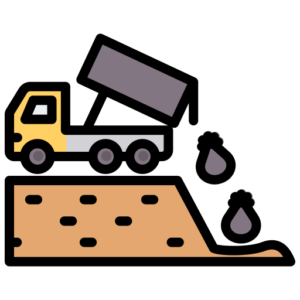24/7 EMERGENCY SERVICES
317 Loring Road Levittown NY 11756
Garbage Disposal

A garbage disposal is a convenient appliance installed under a kitchen sink to shred food waste into smaller pieces, allowing it to flow easily through plumbing. Proper care and maintenance of your garbage disposal can extend its life and prevent plumbing issues.
What Is a Garbage Disposal?
A garbage disposal is a motorized device attached to the drain under a sink. When turned on, it grinds food waste into tiny particles using a rotating impeller plate and grinding chamber. These particles are then flushed away with water through the plumbing system.
Benefits of a Garbage Disposal
-
Convenience
- Makes cleaning up after meals faster and easier by disposing of food waste directly in the sink.
-
Reduces Trash Volume
- Less food waste means fewer trips to take out the trash.
-
Minimizes Food Odors
- Keeps decomposing food out of trash bins, reducing unpleasant smells in the kitchen.
-
Environmentally Friendly
- Reduces the volume of food waste sent to landfills, where it would produce methane gas.
How to Install a Garbage Disposal
1. Gather Tools and Materials
- New garbage disposal unit
- Plumber’s putty
- Screwdriver
- Wrench
- Bucket and towel
- Electrical outlet (if required)
2. Remove the Old Sink Strainer
- Disconnect the drainpipe and P-trap using a wrench.
- Unscrew the sink strainer and clean the area around the drain hole.
3. Attach the Mounting Assembly
- Apply plumber’s putty around the sink flange and insert it into the sink hole.
- Secure the mounting assembly underneath the sink using screws.
4. Connect the Disposal Unit
- Align the disposal with the mounting assembly and lock it into place.
- Attach the dishwasher drain hose, if applicable.
5. Connect to Plumbing
- Reconnect the drainpipe and P-trap to the disposal outlet.
6. Wire the Disposal
- Plug the disposal into a dedicated outlet or connect it to a wall switch following the manufacturer’s instructions.
7. Test the Unit
- Run water into the sink and turn on the disposal to ensure it operates correctly.
Proper Use of a Garbage Disposal
-
Use Cold Water
- Always run cold water while operating the disposal to solidify grease, making it easier to grind.
-
Feed Slowly
- Feed small amounts of food waste into the disposal at a time to avoid overloading it.
-
Grind Appropriate Items
- Safe items: soft food scraps, small bones, and vegetable peels.
- Avoid: grease, oils, fibrous foods (e.g., celery, corn husks), and non-food items.
-
Run After Use
- Keep the disposal running with water for a few seconds after grinding to flush out debris.
Common Issues and Troubleshooting
1. Disposal Won’t Turn On
- Cause: Power supply issue.
- Solution: Check the circuit breaker, outlet, and reset button on the unit.
2. Disposal Hums but Doesn’t Grind
- Cause: Jammed impeller or flywheel.
- Solution: Turn off the unit, use a hex wrench to manually rotate the flywheel through the bottom opening, and clear any obstructions.
3. Slow Drainage
- Cause: Clogged pipes.
- Solution: Use a plunger or a plumbing snake to clear the blockage.
4. Foul Odors
- Cause: Food buildup inside the disposal.
- Solution: Clean with a mixture of baking soda and vinegar, followed by ice cubes and lemon slices to freshen the unit.
5. Leaking Disposal
- Cause: Loose connections or damaged seals.
- Solution: Tighten connections and replace seals if necessary.
Cleaning and Maintenance
-
Daily Maintenance
- Run cold water for 30 seconds after each use to flush out debris.
-
Weekly Cleaning
- Sprinkle baking soda into the disposal, pour in vinegar, and let it fizz for 10 minutes before rinsing with hot water.
-
Monthly Deep Cleaning
- Grind ice cubes and salt to remove buildup from the grinding chamber.
- Use a brush or sponge to clean under the rubber splash guard.
Signs You May Need a New Garbage Disposal
-
Frequent Jams
- Older units may struggle with grinding food waste efficiently.
-
Persistent Odors
- If thorough cleaning doesn’t eliminate odors, the unit may have internal buildup or damage.
-
Leaks
- Cracks in the unit or worn seals may indicate it’s time for a replacement.
-
Reduced Performance
- If grinding takes longer or the unit is noisier than usual, consider upgrading.
Environmental Considerations
-
Use Responsibly
- Avoid grinding excessive food waste to minimize strain on wastewater treatment systems.
-
Dispose of Grease Properly
- Never pour grease or oil into the disposal as it can solidify and clog pipes.
-
Choose Energy-Efficient Models
- Opt for units with energy-saving features to reduce electricity usage.
Cost of Garbage Disposal Installation and Repair
-
DIY Installation
- Costs $100–$300 for the unit, plus minimal expenses for tools and materials.
-
Professional Installation
- $200–$500, including labor and materials.
-
Repair Costs
- $75–$200 depending on the issue and required parts.
Conclusion
A garbage disposal is a valuable addition to any kitchen, providing convenience and reducing food waste. Proper installation, regular maintenance, and mindful usage can keep your disposal functioning efficiently for years. If issues arise, simple troubleshooting steps often resolve common problems, but professional help is available for more complex repairs.
Newsletter
Drain cleaning involves removing clogs, debris, and buildup from pipes to restore proper water flow. It ensures smooth drainage, prevents blockages, and protects plumbing systems from damage. Professional drain cleaning uses tools like hydro jetting or augers for efficient and lasting results.
Design By Oll Solutions

